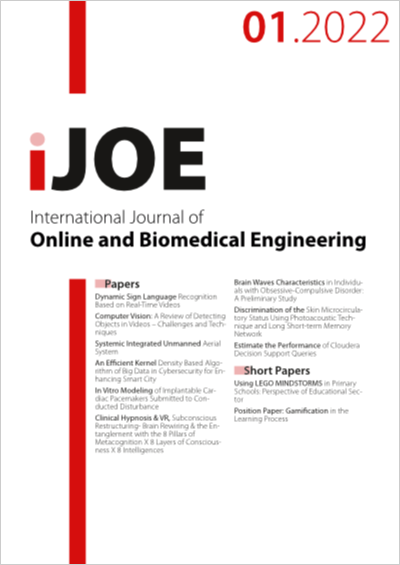Brain Waves Characteristics in Individuals with Obsessive-Compulsive Disorder: A Preliminary Study
DOI:
https://doi.org/10.3991/ijoe.v18i01.26805Keywords:
Obsessive-Compulsive Disorder, EEG, Statistical Analysis, Linear Discrimination Analysis, LocalizationAbstract
Obsessive-compulsive disorder (OCD) is a mental illness causing patients to suffer from recurring undesirable thoughts (obsessions) conducting to do affairs repetitively (compulsions). Brain signals recorded by Electroencephalogram (EEG) can be analyzed in order to present a diagnostic procedure considering the localization approach. In this study, the signals acquired by EEG have been recorded from three groups; two case groups; patients with severe obsessive symptoms and patients with severe compulsive symptoms, and one healthy control group. Brain signal processing techniques have been applied on the signals emitted from frontal and parieto-occipital regions to discover the features leading to the best discrimination between case groups and healthy controls. In this regard, after preprocessing, the features of time and frequency domains presenting the significant meaningful relation were nominated for classification by linear discrimination analysis (LDA). Although the parieto-occipital region performed better in the diagnosis for both obsessive and compulsive groups, the features gained from the frontal cortex resulted in better discrimination for only the compulsive group. In addition, time domain features had a more significant influence in diagnosis rather than frequency domain for both case groups. The study presented particular characteristics of brain signals in two dimensions of OCD in specific brain regions leading to more accurate presurgical assessments in the studies between the affected brain regions and behavioral issues.
Downloads
Published
How to Cite
Issue
Section
License
Copyright (c) 2021 Tahereh Najafi, Rosmina Jaafar, Kiomars Najafi, Fatemeh ESLAMDOUST-SIAHESTALKHI

This work is licensed under a Creative Commons Attribution 4.0 International License.



